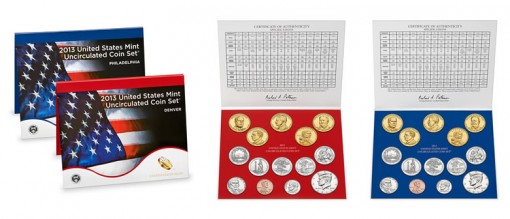This fifth article in a series about our visit to the U.S. Mint at Denver, Colorado, describes how uncirculated coin sets are made.
It’s a blast watching numismatic coins coming to life in coining presses and then seeing how they’re packaged into sets by robots and other automated machines.
Most recently, we were lucky enough to discover how the tech teams from the U.S. Mint at Denver use robotics to build annual United States Mint Uncirculated Coin Sets. These popular sets, which most collectors call "Mint Sets," have annual sales of several hundred thousand units.

We observed probably several hundred sets made just in our short time there. We watched how smart robots pick up uncirculated coins, detect if they are upright, determine their orientation and then place them into opened blister packs. Then we saw how the packs get sealed, snapped inside a coin folder, and dropped off for inspection.
Here’s how it all happens…
Uncirculated Coins Get Placed into Blister Packs
Annually issued Mint Sets include 28 coins of the year with 14 uncirculated coins from Denver presented in a red folder and 14 uncirculated coins from Philadelphia displayed in a blue folder. Ironically, while we watched how Mint Sets were created from scratch and that’s what this article is about, we must have been dazed by the day’s events because we forgot to take photos of the finished folders. Here are U.S. Mint images of their set for 2013:

Now that we’re hopefully on the same page, let’s see how the coins are packaged and get into these folders.
Clear blisters are used to hold coins in place and protect their surfaces. At the rate of about 850 per hour, empty blister packs are fed into a long packaging machine.

A stop and go conveyor system moves the packs to coining stages that are identified by denomination, beginning with Kennedy halves and Jefferson nickels, rotating through the five America the Beautiful Quarters and five $1 coins, and ending with Lincoln cents and Roosevelt dimes.
Before jumping into the robotics of how uncirculated coins get plucked and placed, here are several photos and a video of the blister packaging machine.


This video offers a look inside of the blister packaging machine. It was taken from the center of the machine while turned off, and pans from left to right.
Robots with Cameras Grab Uncirculated Coins
It’s all about the robotics now. Blister packs move down the line on conveyors, they stop at a coining stage and then a robot picks up an uncirculated coin and places it into a pre-programmed position on the blisters. Smart technology is in play here. The "head" of each robot arm has a camera that detects whether coins are upright and in proper rotation. If the robot senses a problem, it drops the coin into a holding bin instead of placing it on the blister pack.



In this video, a robot scoops up uncirculated coins and places them on blister packs.
Blister Packs Get Sealed
Blister packs must be flipped shut and sealed after all 14 uncirculated coins are set into position. This video shows the automated process of closing the packs.

Blister Packs are Inserted into Red Folders of Mint Set
Now, each sealed blister pack with its uncirculated coins must get inserted into a red folder that includes artwork, Denver labeling, specification of the coins and a U.S. Mint Certification of Authenticity. This happens automatically.

A robot picks up an unassembled folder, squeezes it through a frame so it bends at its scored seams, and then places it on a conveyor. The now partly bended folder is moved further down the line where it meets up with a six-fingered robot that has grabbed a package of blistered coins. The robot snaps the blister pack into the waiting folder. From that point, the folder with coins gets glued and moves down the conveyor to await manual inspection and boxing. The following video shows how blister packs and folders are combined.
Inspection of Uncirculated Coin Sets
Here, at the end of the line, Nathan Wittstruck and Bob Luethje inspect uncirculated coin sets and place them into boxes for temporary storage.

Machine Combines Denver and Philadelphia Uncirculated Coin Sets
Finally, a fully automated boxing machine combines the Denver uncirculated coin sets in the red folders with the blue folders of the Philadelphia uncirculated coin sets. It’s quick and able to complete about of 2,100 sets per hour. The machine, not running during our visit, also boxes up the sets.

How popular are the sets? Priced at $27.95 and released on June 4, 2013, just shy of 350,000 of the 2013 Mint Sets have sold to date. Sales of the 2012 Mint Sets topped 395,000 before they unexpectedly went off sale. This year’s 2014 Mint Sets are scheduled to launch in May.
Final Article in Series About the Denver Mint
Return Monday, Jan. 27, for the last article in our series about the Denver Mint. It offers final comments and includes all of the photos we’ve published. To catch up on any articles, there are links to them in the upper right column.





